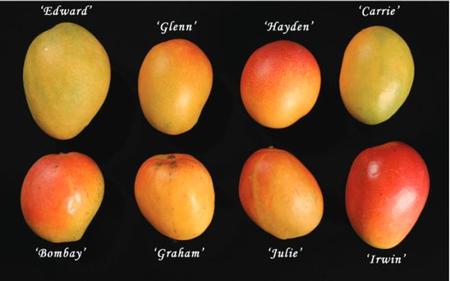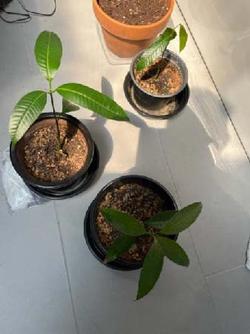The Latest Dirt - Sept 2022
Mango Plants Are in Need of Help
By Terry Lippert
Dear UC Master Gardener,
My mango plant seems to have stopped growing. I have several of these plants which I have sprouted from a seed. Does it require fertilizer to continue to grow? The plants are several months old. Thanks.
Terry Lippert’s response:

Thank you for contacting our UC Master Gardener Program’s Help Desk with your question about growing mangoes from seed. I chose your question to answer because I have always considered mangoes to be a tropical fruit and I didn’t think it could grow outside a greenhouse in Contra Costa County. I thought that the occasional winter freezing temperatures we have most years would doom the trees. So, I wondered why you would be trying to grow mango trees from seeds.
To my surprise, I learned that mango trees can be grown successfully from seed and that in many areas of our county they grow outdoors into large, fruit-bearing trees. I did an internet search, “Do mango trees grow in Northern California?” My search results included many YouTube videos showing mango trees growing and producing fruits in many areas within USDA’s climate zone 9b, including Pittsburg, CA. (I also watched videos showing trees growing in Fresno and Modesto, both of which are also in USDA Zone 9b, and heard references to trees growing in Fremont, CA). The YouTube presenters often thought they were showing the mango tree growing in the most northern climate zone possible.
Much of Contra Costa County is within USDA Zone 9b, including the central areas (e.g., Concord, Walnut Creek), eastern areas (e.g., Antioch and Brentwood) and Southern areas (e.g., Danville and San Ramon). The more western areas of our county (e.g., Richmond and El Cerrito) are in USDA Zone 10a. That climate zone does not get as many freezing temperatures, but the marine-influenced weather in western parts of the County also results in cooler temperatures in the summer months. Because mango trees need plenty of hot sunshine, it may be more challenging to grow them in that area than in the more inland regions.

I also learned from my research is that some mango varieties are monoembryonic and other mango varieties are polyembryonic. The seed of a variety that is monoembryonic will produce a single sprout that can grow into a new tree. That sprout will be a hybrid plant. The fruit from such a hybrid will not be the same as the fruit from which the seed was obtained. The quality and taste of the fruit could be worse, about the same, or better than the fruit that produced the seed. For that reason and because monoembryonic varieties grown from seeds may take ten years or more to produce, monoembryonic varieties are usually grafted with the desired fruit type, rather than grown from seed.
Polyembryonic seeds will produce multiple sprouts—sometimes up to four or five, each of which can grow into a new tree. One of the sprouts will be a hybrid type, but all the other sprouts will be a clone of the mother tree and will produce the same type of fruit. As the sprouts develop, it is sometimes possible to know which is the hybrid sprout because it may grow more slowly or look different than the other sprouts.
As noted, trees grown from seed of monoembryonic varieties take a long time to produce fruit—as much as 10 years or more. By contrast, trees grown from the polyembryonic varieties can produce trees as soon as 2 to 5 years. I mention these facts since you may know from having started the seedlings whether they each grew from a separate seed (suggesting that they may be monoembryonic) or whether all the seedlings started from a single seed, which would mean they are polyembryonic (except for one seedling).
If you decide your seedlings are monoembryonic, you might want to think about starting over with a polyembryonic variety, if your primary goal is to create a producing tree with good fruit quality. Here’s a list of a few varieties of mango which are polyembryonic: Kensington Pride or Bowen, Bullocks Heart, Bundaberg Late, Kasturi, Champagne, Honey, Altaufo, Manila, Chandraka. I have had both Honey and Altaufo mangoes and found them to be very tasty.
Your email indicates that you have become concerned that your seedlings appear to have stopped growing. You wondered whether you should start fertilizing the seedlings. Here’s some information that I found about fertilizing mango seedlings. The California Rare Fruit Growers website has this recommendation:
“Mango trees require regular applications of nitrogen fertilizer to promote healthy growth flushes and flower production. Chelated micronutrients, especially iron, are also often necessary. A feeding program similar to one used for citrus is satisfactory, but do not fertilize after midsummer. Organic fertilizers perform best since the trees are subject to fertilizer burn. Young trees are particularly sensitive to over-fertilizing but respond well to fish emulsion. Sandy soils require more fertilizer than loam or clay." (Emphasis added by author.)
Based on this recommendation, I suggest that you look for a liquid fish emulsion fertilizer to use on your small trees. Follow the directions on the label for the amount to use and the frequency of the applications, but keep in mind that the manufacturer may recommend more frequent applications than needed since that helps boost sales. I generally follow the recommendations for amounts to add to water but cut back on the frequency—for example, if weekly applications are suggested, I might stretch it to every two weeks. After the trees are growing well and have been moved out of pots and into the ground, you’ll need to adjust your fertilizing approach. Both Purdue University and University of Florida have information on fertilizing mangoes (also see website links listed below).
In addition, the trees need plenty of sunlight. If you have been growing them inside, they may not be getting enough sunlight to grow well. If that is the case, you might want to start moving them outside. If they have been growing indoors, transition the plants slowly since they will be very sensitive to the sun and could easily burn if abruptly moved outside. The plants will also take some time to get accustomed to wind. If the plants have been growing inside, I suggest you start by putting them outside in the morning hours while temperatures are still relatively mild. If winds are strong, protect them. Ideally, they would move somewhat in the wind to strengthen, but you don’t want them to be battered by the wind. Leave
them in a sunny area for just an hour or so. Then you can move them into a shaded area that isn’t too windy. Each day, gradually increase the time that the plants are in full sun and exposed to winds.
Let’s hope that the fertilizer and perhaps increased sunlight will help spur the growth. As the seedlings develop, you may want to move them into larger pots or find a place to put them into the ground. Ideally, the permanent location would get plenty of sunlight and perhaps be near a wall or other structure that might provide some reflective heat in winter months. (Two mango trees in Fresno that were shown in the YouTube video were both growing close to a fence.) While the trees are small, they will be very vulnerable to freezing temperatures. You would be wise to have a frost cover available to use to protect the trees when temperatures are expected to be in the low 30s F. As the trees mature, they should be able to sustain somewhat colder temperatures, but they will still be at risk if the temperatures are below about 28° F. (That’s the reason reflected heat from a nearby wall or fence may help.)
Good luck with your trees; I hope that they start growing well and reward your efforts with fruit in the not-too-distant future.
Websites about growing mangoes that I found helpful:
- California Rare Fruit Growers:
https://crfg.org/wiki/fruit/mango/ - Texas A&M information on growing mango trees from seed:
https://aggie-horticulture.tamu.edu/fruit-nut/fact-sheets/mango/ - University of Florida’s information on growing mango trees:
https://edis.ifas.ufl.edu/pdffiles/MG/MG21600.pdf - Purdue University information on growing mangoes:
https://hort.purdue.edu/newcrop/morton/mango_ars.html - This UC website lists many UC and non-UC websites with information on mangoes:
https://fruitsandnuts.ucanr.edu/datastore/?ds=391&reportnumber=612&catcol=2806&categorysearch=Mango
